"Man schnitzte das Holz nicht mehr, man spann nicht mehr, man webte nicht mehr die gute Leinwand wie früher"1, 'No-one carved wood, no-one spun, no-one wove the good linen as before', lamented Henry van de Velde in 1898 the English society of the second half of the 19th century that stood proxy for large parts of Europe as industrialisation became the established norm in ever more arenas, continuing, 'the machine, which turns imbecilically around itself and moves thanks to the pestilential steam, replaced the delicate gestures of the hand animated by the living breath of man'.
With the exhibition Reform of Life & Henry van de Velde mittendrin, the Kunstsammlungen Chemnitz discuss and explore how Henry van de Velde sought to strengthen and reinforce the carving, spinning, weaving and other expressions of the 'hand animated by the living breath of man', and in doing so not only became a key protagonist in the development of Art Nouveau and a key architect of the path to contemporary product and industrial design, but also came to stand today as an important and instructive voice in contemporary social, industrial, creative and technological discourses.......
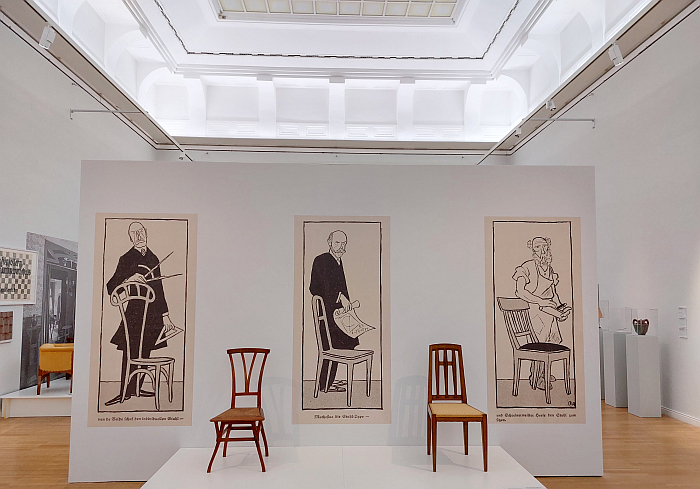
Born on April 3rd 1863 in Antwerp, Belgium, Henry Clemens van de Velde's professional path began as a student of the Koninklijke Academie voor Schone Kunsten van Antwerpen, and primarily in painting, before in the early 1890s he switched, as with numerous other equally interesting and informative artists of that period, to applied arts and architecture, and that, amongst other reasons, from a desire to improve the quality of an everyday life a great many considered blighted by the confusions of the various stylistic revivals we refer to today as historicism, and by a contemporary machine production that was not only understood as unhealthy in a medical, clinical, sense, but whose low-quality, low-value, products were understood as unhealthy in a cultural sense, through the development of more artistic, more attractive, more meaningful, contemporary, actively designed, buildings and objects of daily use. Through a reform of how the world around us was approached, constructed and interacted with.
And an 1890s where Reform of Life & Henry van de Velde mittendrin, Reform of Life & Henry van de Velde in the midst of it all, opens, and that with, as one of the first items on display, an example of a so-called Reformkleid, Reform Dress, an object so closely associated with the Reform spirit of the age in which it arose that they named it after it. A Reformkleid concept developed to not only ease the physical movement, and physical and mental health, of women but to underscore the novel positions and roles women were taking on as society reformed. If a Reformkleid that was regularly designed by a man: Reform, yes, but only to a degree that men are comfortable with. A comfort of men with the pace of reform that, arguably, had priority over the comfort of women in their pretty new dresses. And that is worth reflecting on in context of today.
Whereby in the interest of fairness, and by way of balancing, countering, our deep-rooted cynicism of late 19th/early 20th century European society, and of 21st century European society, the Reformkleid from ca. 1896 on show in Reform of Life is credited to Henry and his wife Maria; Maria van de Velde, neé Sèthe, being an active creative in her own right, and that beyond Reformkleider, and a creative who, as Henry himself oft noted, was an important, equal, contributor to projects today credited to him alone, thereby aligning Maria van de Velde with the likes of, for example, an Aino Aalto, a Lilly Reich or a Lucia Moholy who (his)tory, has unfairly left undervalued and underappreciated through not recording their full contribution to a joint creative enterprise with their more visible male partner.
With the myriad problems such a skewing of (hi)story through (his)tory brings with it.
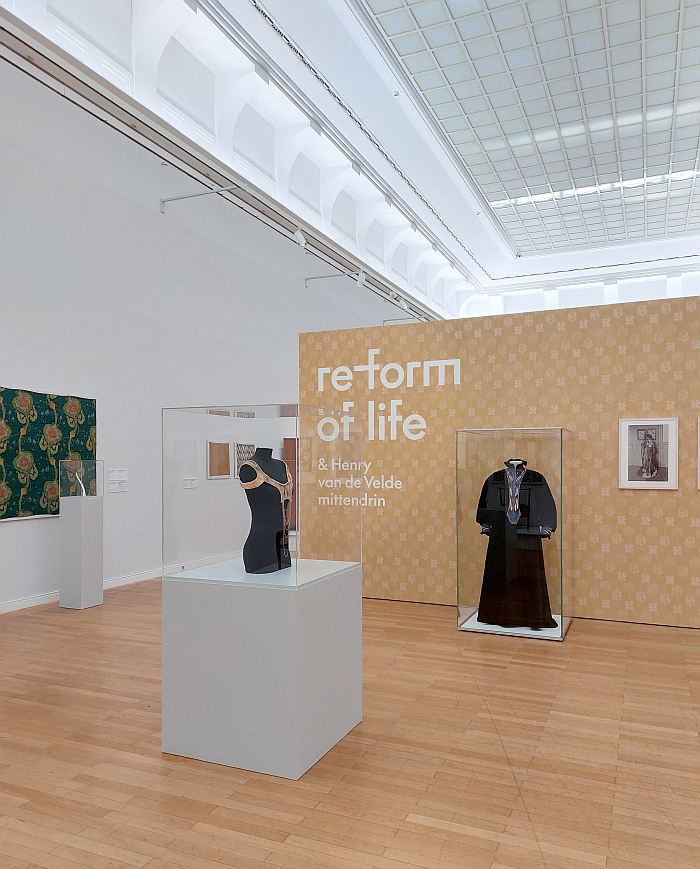
A, then, Maria Sèthe, who in her early 20s had travelled to London to learn more about the Arts & Crafts movement, that first reaction to the "machine, which turns imbecilically around itself and moves thanks to the pestilential steam" which arose in England through the efforts of the likes of a William Morris or a John Ruskin; a Ruskin who inspired the above quoted lament on 19th century England, a quote to be found on a wall in Reform of Life like a piece of activist graffiti shouting through the ages, that neatly reinforces what an important influence Ruskin was on Henry van de Velde's positions, and his, and many of his contemporaries, switch from decorative, fine, art to applied, utilitarian, art and craft. And an influence of the Arts & Crafts movement on not just van de Velde but on the development of Art Nouveau in its various dialects across continental Europe, that can be appreciated in Reform of Life's opening chapter through the presence of works by the likes of, for example, Arthur Silver or Mackay Hugh Baillie Scott, the latter represented via a variety of works including a chair for the Dresdner Werkstätten für Handwerkskunst Hellerau, a.k.a. Deutsche Werkstätten Hellerau, that not only helps elucidate the networked international nature of creativity at that period, nor only implies the important role of manufacturers such as the Hellerau Werkstätten in mediating the novel positions of the age, but which also allows one to begin to chart the movement of the positions of the Arts & Crafters from then to now.
An opening chapter that also introduces the, oft noted in these dispatches, importance of Japan in and for the development of European Art Nouveau following the ending in 1868 of Japan's 265 years of self-imposed and self-enforced global isolation, the so-called policy of Sakoku, and the fascination with which all the previously unknown materials, approaches, practices, subjects and positions of Japanese creatives of all ilks was received in Europe. Including by Henry van de Velde as can be appreciated via a late 1890s picture frame for an unnamed, uncredited, Japanese print; a frame that rises, falls, swells as if mimicking the waves, clouds, landscapes of a Katsushika Hokusai and thereby also tends to expand the floral influences of much of Art Nouveau to an influence of wider natural phenomenon, and thereby underscores how nature informed the art and design of the period while remaining something to be harnessed and controlled by man. That, as noted from Plant Fever. Towards a Phyto-centred design at Schloss Pillnitz, Dresden, important and instructive difference between then and a now where, while nature remains an important informant, working with nature, of treating nature as a partner, is understood as the better option. Or at least is by a great many, if not (yet) all.
And an influence of Japan on late 19th century Europe that also allows one to approach questions of the borders between inspiration and appropriation; questions that become amplified a couple of rooms later via the batiks by Johan Thorn Prikker, that interesting protagonist of Art Nouveau in Nederland; and a batik process very popular at the turn of the 19th/20th centuries in the Netherlands that represents the use of a vernacular process from the contemporary Indonesia by creatives from the Netherlands, who at that time were the colonial power of the, then, Dutch East Indies. ¿Inspiration or appropriation?
Batiks that thereby also remind that the reforms under discussion in Reform of Life are very much reforms within Europe, as viewed with a European gaze.
While the similarity between the ca. 1900 batik cushion cover by Prikker and the ca. 1903 batik topped table by van de Velde poses other question about 'inspiration' amongst the networked international creatives of the age; and a table created in Germany by a Belgian 'inspired' by a Dutchman’s ¿inspiration? ¿appropriation? of an Indonesian craft that poses questions of the 'nationality' of design, of that claim for a 'national' design, for design as being something contained and definable by administrative borders, that is still so oft made today, yet is rarely if ever defensible beyond the selfish sphere of marketing.
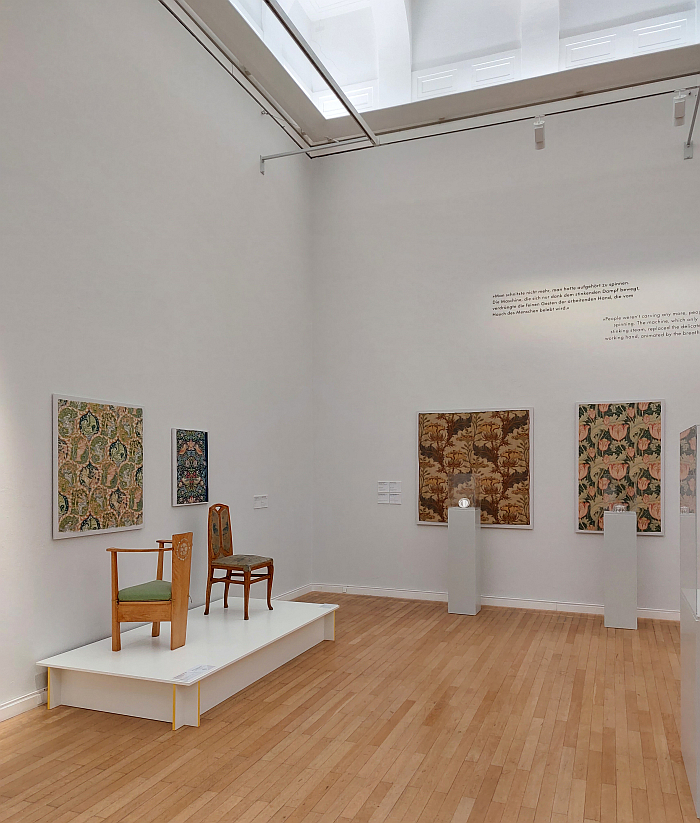
From its introduction to the background, motivations and inspirations to and of the creative atmosphere of the late 19th/early 20th centuries Reform of Life moves on over chapters exploring, for example, the relationships between the rise of commerce and objects of daily use in their physical and metaphysical existences, not least through the rise of department stores as locations for a conspicuous consumption fired by the profits of the "pestilential steam", thereby underscoring the complexity of the relationships between creativity and commerce in that age, and indeed in our age, or developments in furniture design, production and distribution as the 19th century ceded to and became the 20th century. Chapters discussed via and populated by works from both Henry van de Velde and many of his contemporaries including, for example Richard Riemerschmid, Bernhard Pankok, or Gertrud Kleinhempel, the latter represented by a variety of sketches and objects including a ca. 1901 bedside table for the aforementioned Dresdner Werkstätten für Handwerkskunst Hellerau, a deceptively unobtrusive object that does that delicious thing the Aaltos later did with wood of layering it in such a manner so as to give the impression of an intricate carpentry it inherently rejects. A layering that through disrupting the silhouette also bequeaths the object a graphic element; a graphic element that all too often is understood as the antithesis of a reserved reduction, but is, arguably, an important, fundamental, element of any reserved reduction, one which if missing devalues any and every object, but which shouldn't be present in the ornate, shouty, forms of so much Arts & Crafts, Art Nouveau or Art Déco, and in doing so not only allows Kleinhempel's bedside table to have the agency it does, but enables one to better locate Kleinhempel on the helix of design (hi)story.
And a bedside table which also introduces to Reform of Life's narrative the increasing importance and role of the machine that was initially rejected, but which became increasingly accepted in the course of the early 20th century once the relationship with it was redefined; a reform of relationships with the machine that was as important, and as profound, and as essential, as the reform of life that it enabled and that guided it. Something also very, very, neatly elucidated by the example of an object of Riemerschmid's Maschinenmöbel that lies near Kleinhempel's works. Maschinenmöbel, one notes, and that not en passant, also developed in cooperation with the Hellerau Werkstätten.
Reform of Life, or certainly the exhibtion when not necessarily the process, or more accurately the exhibition in the Kunstsammlungen am Theaterplatz, ends with an exploration of Henry van de Velde's contribution to creative education, starting with what the curators refer to as his "Workshop Principle", a principle not exclusive to van de Velde, rather one that was at the foundation of much of the reform of creative education in the early 20th century, if one in and with which van de Velde was particularly influential and pioneering, and an interactive chapter that invites one to actively resist the "pestilential steam" of the machine and to emboss, stamp and weave, before introducing what van de Velde describes as his four citadels: his 1902 initiated Kunstgewerbliches Seminar, from 1908 Kunstgwerbeschule, Weimar, which van de Velde later described as, "the most progressive citadel of the new artistic principles"2 of the period, and looking back there is an argument to be made that he has valid argument; the Staatliches Bauhaus Weimar which sought to combine the remains of the van de Velde Kunstgewerbeschule with the Staatliche Hochschule für bildende Kunst — Kunst und Handwerk eine neue Einheit, Art and craft a new unity, as Walter Gropius once defined his ambition with Bauhaus — a Gropius who was in close contact with van de Velde, and Bauhauses of which van de Velde proclaimed had "eclipsed"3 everything his Weimar institution had achieved; the Institut Supérieur des Arts décoratif, a.k.a La Cambre, Brussels which van de Velde led from 1925 until his retirement in 1936, which remains one of the more important design schools in Belgium, and which he refers to as his "pedagogic citadel"4, presumably, by way of differentiating it from the more practical orientated Weimar citadel, a telling differentiation. And as the fourth, the HfG Ulm, an institution to whose formal opening in 1955 "the afflictions of old age"5 prevented van de Velde from attending, but which he clearly understood as a progression of the Bauhauses. That understanding of the HfG Ulm that although not entirely false, isn't entirely true. And certainly isn't helpful.
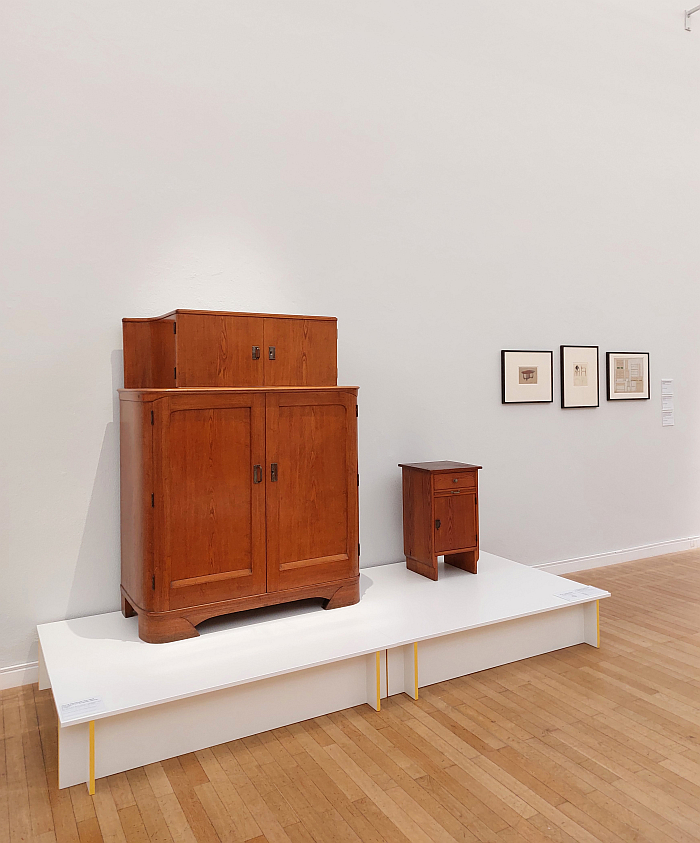
Four citadels, and their contribution to the development of product and industrial design as much as to the development of design education, discussed through and via works realised at the institutions by the likes of, and amongst others, Max Nehrling, Else Mögelin, Otti Berger, Nick Roericht or Chemnitz's own Marianne Brandt, an unjustly regularly overlooked creative who is discussed in Reform of Life not only in context of the Bauhauses but in context of the equally unjustly regularly overlooked 19th century Scottish designer Christopher Dresser, a discussion that further underscores, and illuminates, the path from Arts & Crafts over Art Nouveau and Functionalist Modernism to today.
And four citadels also discussed through and via works by van de Velde, including, for example, a model of a ¿proposed? candlestick holder realised in 1907/08 in conjunction with the Bürgel, Thüringen, based porcelain manufacturer Carl Gebauer, a work that is not only an engaging multi-functional object that could be released tomorrow and delight as much as light, but also a reminder that creativity and creative industry in late 19th/early 20th century Thüringen is and was much more than the Weimar Bauhaus all focus so pathologically on today. Or the monumental desk and more reserved but every bit as self-confident steel tube chair for Ghent University library as realised in the early 1930s, thus towards the end of Henry van de Velde's productive career; a steel tube chair that stands diametrically not just materially and formally but conceptually and programmatically juxtaposed to the ca. 1902 wooden chair by van de Velde one meets in the opening chapter and thus helps elucidate the journey van de Velde, and his positions, took over the intervening three decades, helps elucidate the three decades of reform of Henry van de Velde. Three decades of reform of the objects of daily use to which Henry van de Velde contributed. Three decades of reform that were important to creativity of all hues. Three decades of reform that were important to European society. Three decades of reform that are important to, and instructive for, contemporary creativity and contemporary European society.
And a steel tube chair that in the Kunstsammlungen am Theaterplatz stands next to a B 32 steel tube cantilever chair by Marcel Breuer through Thonet, a pairing that helps you formulate that question stimulated by, demanded by, Mehr als echt (more than real) by Jun Wang at Stiftung Bauhaus Dessau of why some furniture objects, not least the quadratic steel tube furniture of the 1920s and 30s developed by Bauhäusler, are so popular today, so venerated today, and so widely plagiarised today, and other works, specifically steel tube furniture of the 1920s and 30s by non-Bauhäusler or non-quadratic steel tube furniture of the 1920s and 30s by Bauhäusler and by non-Bauhäusler, despite in a great many cases being every bit as engaging, responsive and functional, aren't, aren't and aren't.
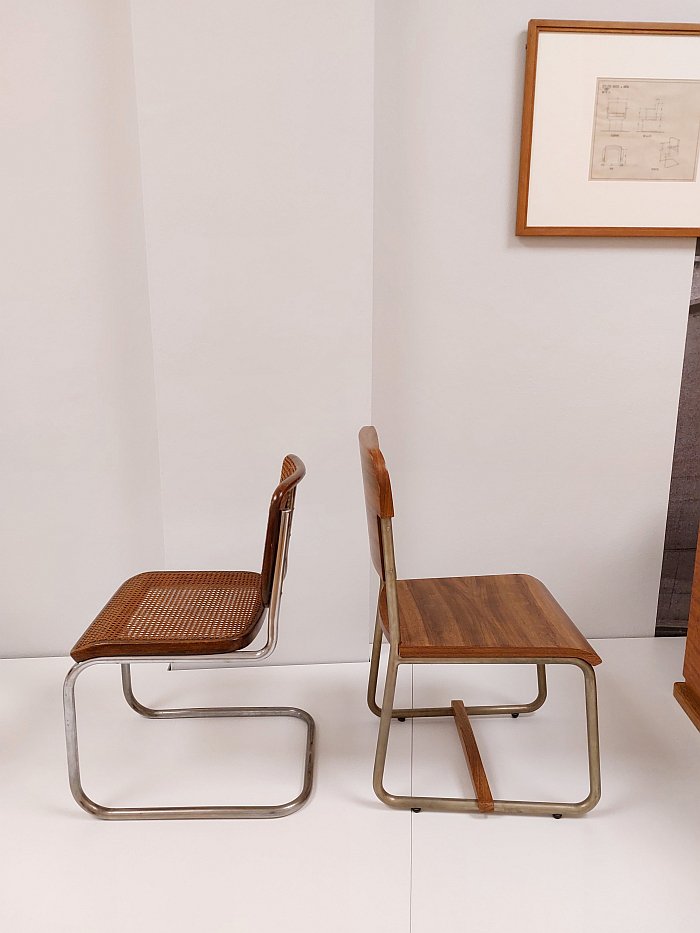
That the Kunstsammlungen Chemnitz are devoting an exhibition to Henry van de Velde is no coincidence.
Nor is the timing.
In 2025 Chemnitz is, along with Nova Gorica, Slovenia, European Cultural Capital, a tenure being celebrated in Chemnitz under the motto, the identity, C_The_Unseen. On the one hand, certainly in its full expression C_The_Unseen - European Makers of Democracy, a focus on the role of us all in shaping civic society, including the role of creativity it all its hues as a mediator in that process, if one so will an expansion of both a Joseph Beuys' Social Sculpture and a Lucius Burckhardt's Design ist Unsichtbar, that Burckhardtian position that it is invariably the unseen interactions, unseen connections, unseen networks, the anonymous, that are responsible for the design of society, for the operation of our communities and built environments.
And on the other, C_The_Unseen is also a very satisfying play on the relative (hi)storical anonymity into which Chemnitz has fallen of late, C(hemnitz)_The_Unseen, Chemnitz as a city that popularly only exists as Karl-Marx-Stadt or post-1990 Chemnitz, and that, we'd argue, largely on account of its DDR biography. A biography, arguably, deliberately developed and enforced to distract attention from the reality that in the late 19th/early 20th century Chemnitz and environs was a driver of innovation in Europe: not only was Chemnitz and environs one of the leading centres of textile production, and of the advancement of new methods of textile production, in Europe, but the region was also one of the cradles of the automotive industry, and in the 1870s Chemnitz had been one of the leading advocates for and protagonist in the passing of the first German Patent Act, and that on account of the level of innovation and invention in terms of developing novel machines that not only "imbecilically" turned around themselves thanks to "the pestilential steam", but through doing so advanced industry and industrialisation. And early 20th century Chemnitz was also the birthplace of the Rowac-Schemel, that early sheet steel sitting solution and thus an important development in both the production and the function of furniture.
A leading place in the industrialisation of the late 19th/early 20th century that while it sounds like the sort of (hi)story any fledgling nation would be keen to exploit, not least by way of staking claim to its place in a new, unfamiliar, War enforced, geopolitical landscape, particularly if that new reality had bequeathed you a neighbour you were very keen to distance yourself from, Chemnitz didn't find itself in any fledgling nation, but in the DDR. A fledgling DDR that not only disavowed and denigrated the role the lands it now occupied had played in the social, technological and creative developments of the 1920s and 30s, including rejecting anything and everything that could be loosely associated with the Bauhauses who had once called the future-DDR home, but also, or certainly one can develop an argument, the DDR authorities were keen to distract attention from the great wealth, and vibrant bourgeois industrial society, Chemnitz had acquired in the late 19th/early 20th century, a wealthy bourgeois industrial society attested to by the city's Kaßberg district, one of Europe's largest Art Nouveau conurbations.
And a wealthy bourgeois industrial society that was able to commission some of Europe's more influential creatives to realise projects for them. Including, mittendrin, Henry van de Velde who, amongst other projects, realised in 1902/03 a villa high on Chemnitz’s Kapellenberg for textile magnate Herbert Eugen Esche.
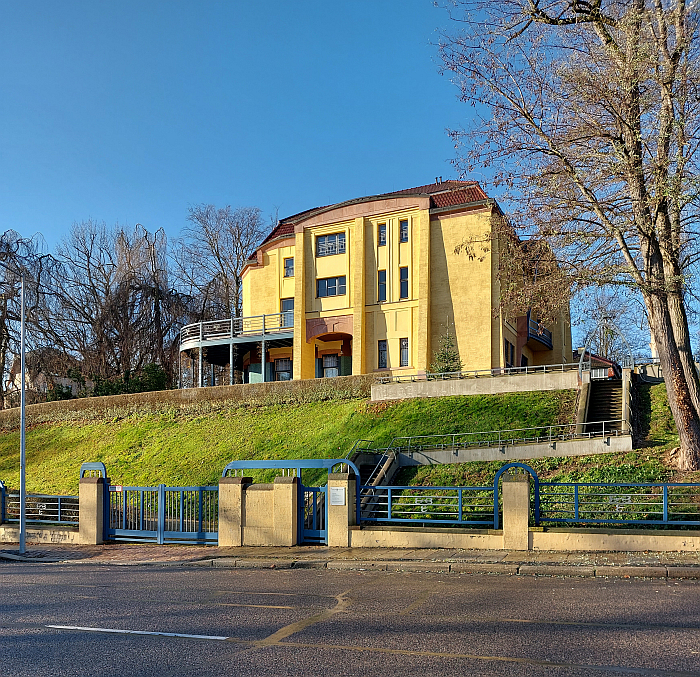
A Villa Esche that today has been restored and in which one can experience rooms settings as devised and designed by van de Velde for the Esche's, and thereby experience van de Velde's work beyond the 'on a pedestal' museum experience, if still a museal presentation; and a Villa Esche that also houses the Kunstsammlungen Chemnitz's Henry van de Velde Museum, where Reform of Life continues with three chapters, starting with a discussion on van de Velde's Art Nouveau dialect via graphic, object and furniture works, and also via a globe designed by van de Velde in 1901 for the manufacturer Otto Berger in Bad Berka, there's Thüringen again. An Otto Berger more popularly known for their lighting design, and a globe which although in Reform of Life you have no opportunity to study in its entirety, you know represents a world very different to ours today.
From Weimar to Belgium which not only discusses that fraught journey van de Velde made from a land he'd called home for many years to the land of his birth in a period of War and distrust in Europe, nor only presents a brief introduction to the person of Maria and her role and relevance as both Maria Sèthe and Maria van de Velde, brief but she is at least present, also features a variety of furniture objects by van de Velde including two desks, one from 1902/03 the other from 1925, the earlier a swirling flowing florid object, the later a much more sober quadratic object, the florid desk featuring drawers, the quadratic storage space with doors, but which are, essentially, exactly the same desk, just created at different moments in van de Velde's development: both feature, essentially, exactly the same elements, components and ideas, are the same appreciation of what is a desk is, should be, must be, but express themselves, express their relationships with the user and with function and functionality very differently. And thus two desks that, as with the comparison between the 1902 wooden chair and ca. 1932 steel tube chair in the Kunstsammlungen am Theaterplatz, allow access to appreciations of the manners in which Henry van de Velde's work and positions evolved over the decades of social, technological, economic et al change, reform, and thereby also appreciations of the two-way interplay between design and society, that both continually inform and influence the other.
The final chapter in Villa Esche, and thus the final chapter of Reform of Life, unfolds in Chemnitz with a brief introduction to some of Henry van de Velde's other Chemnitz commissions, primarily his ever joyous 1907 Lawn Tennis Club, a project that screams, more than any villa, bourgeois 1900s society, and whose tragic demolition in 1959 to make way for housing can be seen as a more meaningful use of land in an age of housing need, or as part of the attempt to deny Chemnitz its bourgeois biography, take your pick. A Chemnitz Lawn Tennis Club which is recalled in Reform of Life predominately via furniture including wooden stools that in their various heights remind that height-adjustable stools are a relatively new development, and by a slatted wooden chair that not only appears to carry itself as both a garden and an interior chair and thus appears to play with its intended use in the interior of an outdoor sports club, although that could be us reading too much in to things, although we like to think not, definitely harks back to Arts & Crafts while incorporating the machine in its design and construction, thereby placing it in a very fluid moment of not just design (hi)story but of social and technological (hi)story.
And also helps one better locate Chemnitz in that moment; a moment that after viewing Reform of Life, and Villa Esche, you can, should, must take the opportunity to seek out in the contemporary Chemnitz.
Much as you can, should, must after viewing Reform of Life seek out Henry van de Velde in the contemporary reform of society, industry, creativity and technology, in the contemporary reform of life.
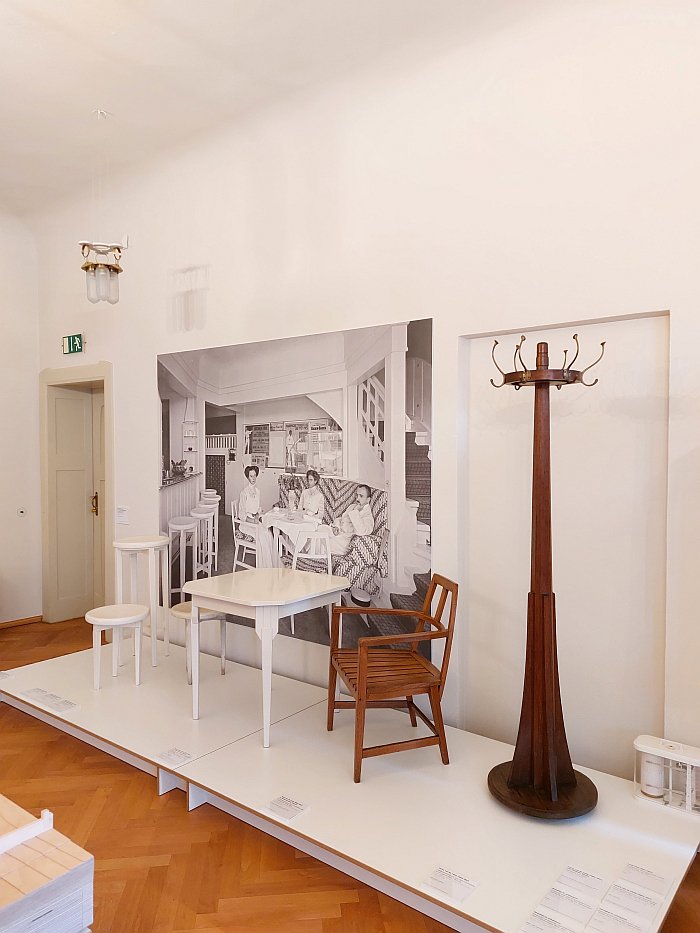
A relatively bijou exhibition, which isn't a criticism just an observation, Reform of Life has a wide scope and aside from providing for a succinct, but comprehensive, bilingual German/English, introduction to the life and work of Henry van de Velde via a presentation that sets Henry van de Velde in a wide variety of contexts and in discourse with a wide number of protagonists, that allows one to C_The_Unseen environments in which his work developed, to C_The_Unseen connections, influences and impulses, and thereby allowing a variety of access points to the man, his work and his legacy.
Including, if more in the accompanying booklet whose various short texts expand on the exhibition than the exhibition halls, his role in in the so-called Werkbundstreit, Werkbund Argument, of 1914, a Werkbundstreit, in which, and summarising more than is probably prudent, a group of creatives around Hermann Muthesius, another very influential adherent of Arts & Crafts in the development of Art Nouveau in the German Empire, and a group led, at least vocally, by Henry van de Velde, engaged in a, by all accounts, very, very, heated exchanged as to whether the future of architecture and design was to be based on a universal library of Typen, standardised forms, or the free will of the creative: Muthesius demanding the former, van de Velde the latter. And a Werkbundstreit that not only underscores the influence of van de Velde at that period, that van de Velde was mittendrin contemporary discourses, but in its fundamental question of how objects of daily use are designed, produced and supplied not only stands as one of the more important moments in the (hi)story of creativity in Europe, in the reform of architecture and design, in the reform of life, that, in many regards, the Arts & Crafters had initiated but which, arguably, can also be followed back to introduction of bronze as a novel material for objects of everyday use, also echoes the dispute between craft and design that was a component of the DDR's above noted rejection of the tenets of Functionalist Modernism, and as beautifully illustrated by the 1952 dispute been Mart Stam and Kurt Liebknecht over furniture production in the DDR. And also echoes in our age and the decisions we needs must make about the provision of our objects of daily use against the background of climate emergency, resource finiteness, War, distrust, rapidly developing novel design and production possibilities, etc, etc, etc.
And a Werkbundstreit also represented in Reform of Life by a copy of Karl Arnold's 1914 cartoon that employs the Werkbundstreit, the distinction between Muthesius, van de Velde, and a Master Carpenter, as the basis for a criticism of contemporary furniture design, and in doing so also highlights not only how design established itself, distinguished itself from applied art and craft, in the early 20th century, but also the origins of the path that, as noted from A Chair and You at the Grassi Museum für Angewandte Kunst, Leipzig, has seen the function of chairs move away from sitting, or more accurately move away from sitting alone.
In addition, thanks to its pleasingly conceived construction Reform of Life also takes you effortlessly beyond Henry van de Velde per se and allows for a concentrated focus on the development of Art Nouveau, Jugendstil, in the lands of the, then German Empire, on the development of creative education in Europe, and also on the role and place of Sachsen, specifically Chemnitz and environs, in the development of design and of objects of daily use in the late 19th/early 20th century. A Sachsen, Chemnitz and environs, focus that that allows one to better approach and appreciate the importance the State and the city enjoyed in the late 19th/early 20th century and thereby makes Reform of Life an exhibition about Sachsen/Chemnitz as much as about Henry van de Velde. Of which we very much approve.
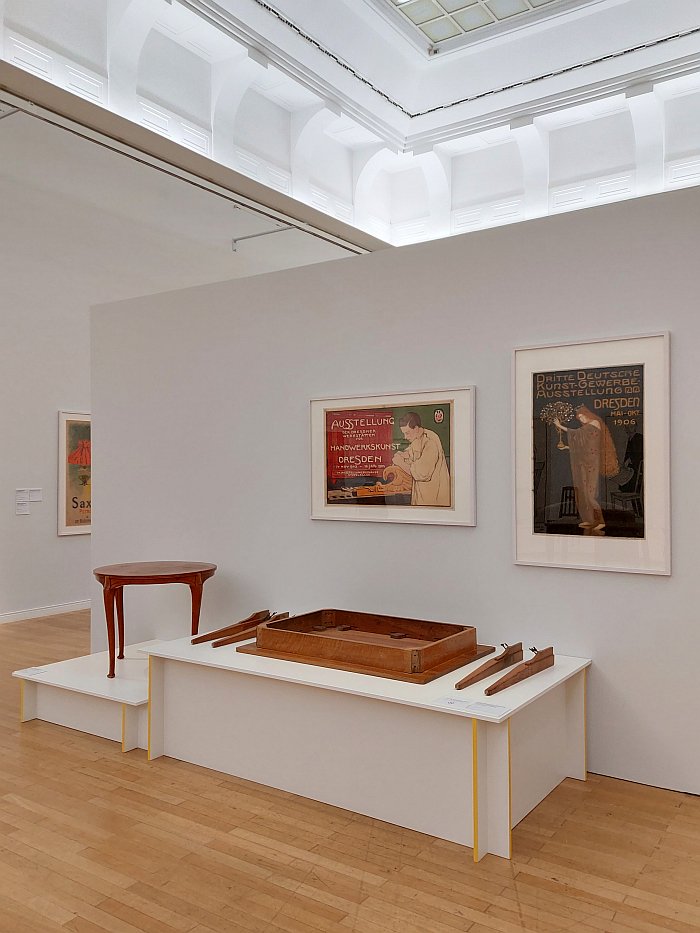
Quite aside from what it can and does mediate about Chemnitz, Sachsen, Henry van de Velde, creative education or design (hi)story, Reform of Life is also an invitation to get up close and personal with a great many interesting and informative works across creative genres by a wide variety of protagonists, see above for just some of those featured; and for all to get up close and personal with a lot of works from across the years and stages of van de Velde's creativity, including, and in addition to those already mentioned, and amongst many others we could mention, but which very real limitations of space prevent us from, a ca. 1901 chair developed for the Hohenzollern-Kunstgewerbehaus, Berlin, one of those aforementioned department stores that were influential in the development of objects of daily use , and a chair that for all its very obvious historical quotations is very much a contemporary object, contemporary then and contemporary now; the so-called Havana armchair from 1897 and an untitled armchair from 1905 that both feature the same bifurcating armrest concept, an armrest that features two places to grasp hold depending on which stage of the stand-to sit-to stand process you currently find yourself in, a bifurcation which in the older chair resembles a fungi in the process of sprouting and in the younger is a piece of simple machine planing, and thus a further, and very simple, illustration of the shift in van de Velde's positions and approaches; a circa 1904 armchair with a positionable backrest that stands in the chapter Henry van de Velde's commissions in Chemnitz, but with sadly no other information, but which pre-dates Josef Hoffmann's Sitting Machine, and while opulent does tend to imply it was familiar with the work of the Shaker communities of North America; a travel rug van de Velde created for the Wilhelm Vogel textile mill, Chemnitz, that further underscores his links with and contributions to the city, and which when viewing you ask why it isn't in production today. ¿Why isn't in production in Chemnitz? Or a floor lamp from 1925 that features at its base what appear to be two fold-out shelves, presumably for plant pots, but which could serve any number of functions, including as seats for cats. And whose fold-out function poses all manner of questions. Predominately, why?
Furniture from across the years and stages of van de Velde's creativity that while one does regularly meet the "modern Belgian curvatures"6 that so offended, provoked and aggravated a great many practitioners of Art Nouveau in the Netherlands, also explains that van de Velde was a lot more, that the flowing florid was but one aspect of his positions. And furniture that also helps explain, as, arguably, also visible in the works of a Kaesz Gyula as seen in Kaesz Homes 1925-1960. The homes of designer couple Kaesz Gyula and Lukáts Kató at Walter Rózsi Villa, Budapest, a shift in van de Velde's work towards Modernism that refuses to fall into the trap of faddism, of a rapid, formalistic, adoption by way of fitting in, rather tends to imply van de Velde, as we'd argue was the case with Kaesz, appreciated the necessity of reform in terms of objects of daily use as society, technology, economics et al reformed, which also implies he didn't reject the novel that was replacing the familiar, but engaged with it, and sought a reflective, considered expression of the novel positions being advanced, while remaining true to oneself.
Which isn't as easy as it sounds.
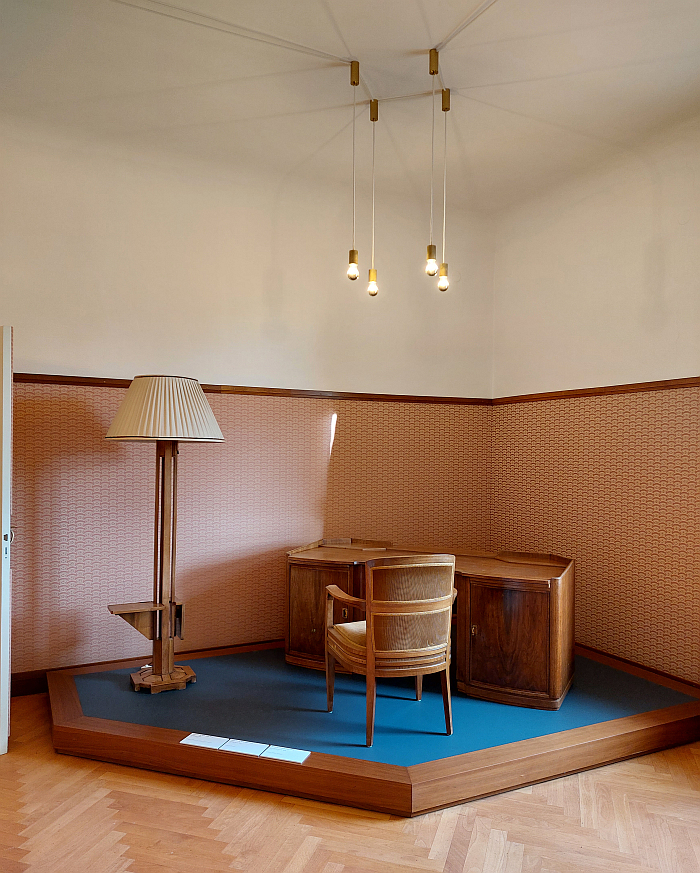
And also allows for an understanding that for all the reform of the late 19th/early 20th century is often described as 'revolutionary', that is largely because of the way looking back tends to warp our appreciations, that way looking back we summarise and thus don't C_The_Unseen, those bits in-between that which we C. Or put another way, the world in 1955 when van de Velde's fourth citadel opened in Ulm was very different to what it had been 1902 when his first citadel opened in Weimar; the passing of fifty years making the past look antiquated, much as the 1970s look antiquated today, and the 2020s will appear antiquated in the 2070s, assuming that is human society makes it that far. Yet for all the differences when looking back, for all the revolutions that have apparently occurred, as Reform of Life allows one to better appreciate the path taken invariably is much more one of evolution: that, yes, everything is very different today than then, but not only was that change a relatively long time coming, much longer than our memory tricks us into believing, but there are a lot of parallels one can, must, make between then and now.
A lot of parallels that we can make between the early 21st century in which Reform of Life is being staged and the late 19th century in which Reform of Life opens.
Not least in context of "the machine, which turns imbecilically around itself and moves thanks to the pestilential steam" and which "replaced the delicate gestures of the hand animated by the living breath of man".
The times we live in are not so very different from those in which Henry van de Velde switched from decorative, fine, art to applied, utilitarian, art and craft; we have today our own conflicts between the machine and human society, our society is defined to a large degree by an open conflict between machines and humans much as the society of the late 19th century was. If very different machines.
But what are our AI and algorithm powered devices if not machines that turn around themselves? 'Imbecilically' is an unhelpful personal opinion van de Velde is entitled to, but which we'll not repeat at this juncture, but also refuse to call such machines the smart they are so blithely and lazily popularly referred to. What are our AI and algorithm powered devices if not machines that intend to replace "the delicate gestures of the hand animated by the living breath of man"? Then it was carving, spinning, weaving, et al the machine was replacing, today it is art, literature, music, et al. And whereas the "pestilential steam" was once visible and caused physical harm, the "pestilential steam" of social media is invisible but every bit as harmful to society, and recent events imply will become ever more harmful to society, and to the social fabric, the metaphorical linen, that supports, carries, any and every society and which we continually weave, even when we cease to weave actual linen. And which needs must be good social linen in order to do its job.
And while a Henry van de Velde and his contemporaries can't provide us with answers as to how we approach our contemporary challenges, for that the differences between then and now are simply too many and too immense, better appreciating how, after faltering starts, false turns, false promises and prophets, and numerous journeys into the abyss, they learned how to work with the machine, they learned how to use the machine, how to negate the inevitable negative consequences of the machine as far as was possible in context of contemporary understandings, how to coexist with the machine, how to enable a society where art and craft had its place and the machine had its place, and where those places were often one and the same, how they reformed their relationship with the machine to enable a reform of society, a reform of life, that was as urgent, necessary and unavoidable then as now, can help us achieve the reforms we must make in our relationships with machines. Reforms in our relationships with machines whose necessity are as tangible today as they were in the architecture and objects of daily use of the late 19th century.
And can help us not least because as a Kaare Klint continually reminds us "Problemerne er ikke saa nye, de er i mange Tilfælde løst før"7, 'the problems are not so new, they have in many cases been solved before', if invariably in different, but extrapolateable, contexts.
Henry van de Velde contributed to solving them in context of his age, and if we choose to place a Henry van de Velde mittendrin our necessary and unavoidable reform of life, there is an argument to be made that he can assist in helping us find ways forward.
But for that Henry van de Velde, and the age of reform he, and Chemnitz, contributed to needs to be brought closer to the centre of contemporary discourses than they currently are.
Reform of Life is a good place to begin that relocation. And to begin to get to know an alternative Chemnitz, one that might surprise you.
Reform of Life & Henry van de Velde mittendrin is scheduled to run at the Kunstsammlungen Chemnitz, Theaterplatz 1, 09111 Chemnitz and at Villa Esche, Parkstraße 58, 09120 Chemnitz until Sunday March 2nd.
Further details, including information on the accompanying fringe programme, can be found at www.kunstsammlungen-chemnitz.de
And further details on Chemnitz’s 2025 European Culture Capital programme can be found at https://chemnitz2025.de
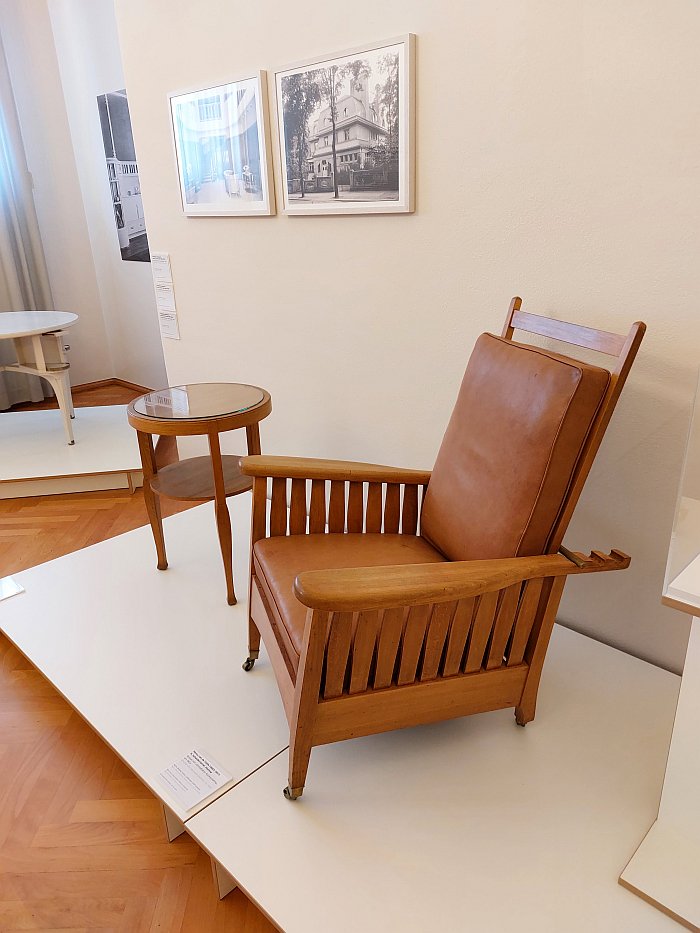
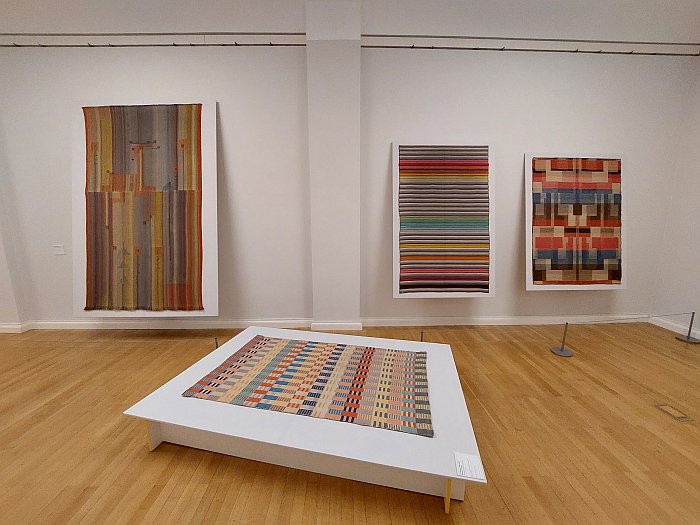
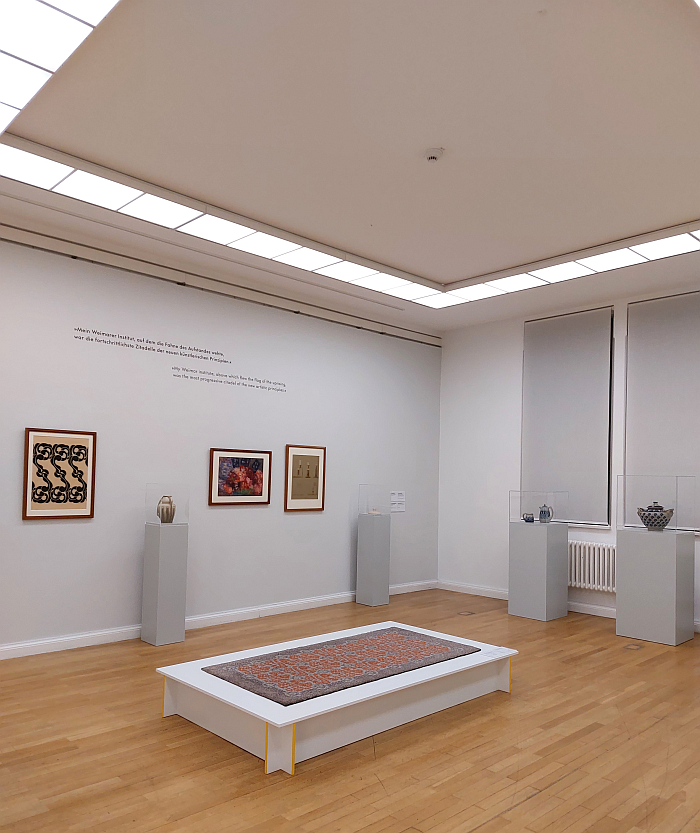
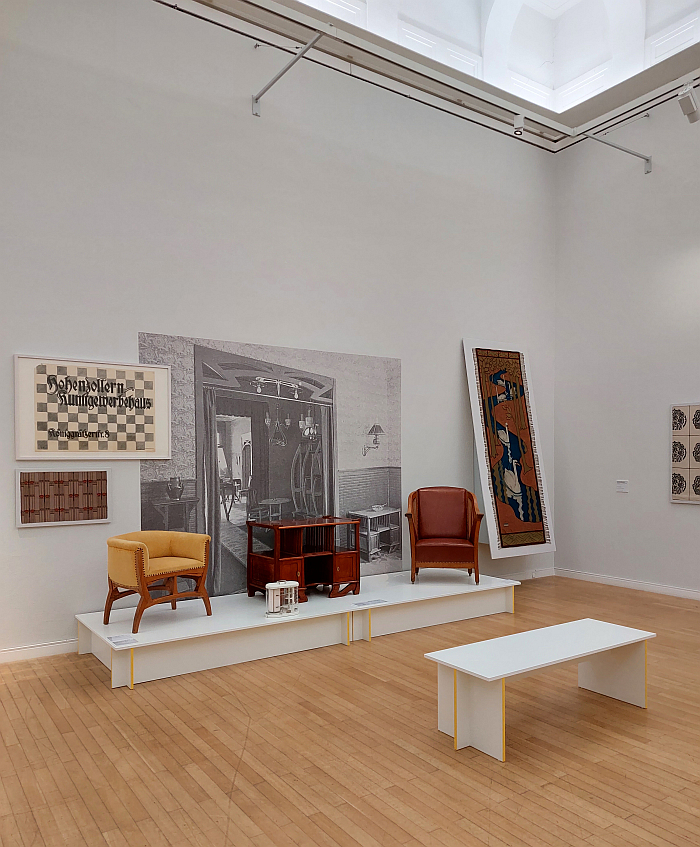
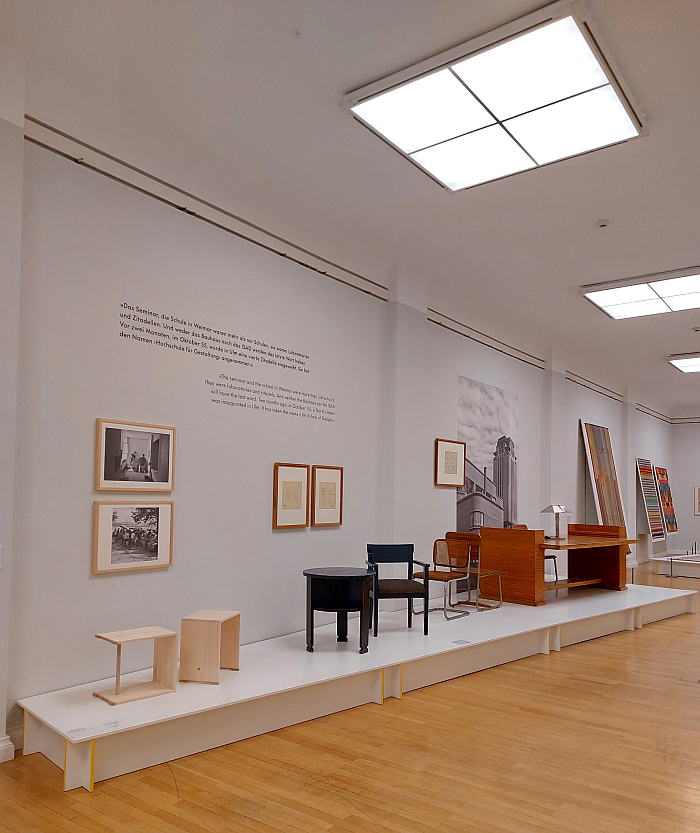
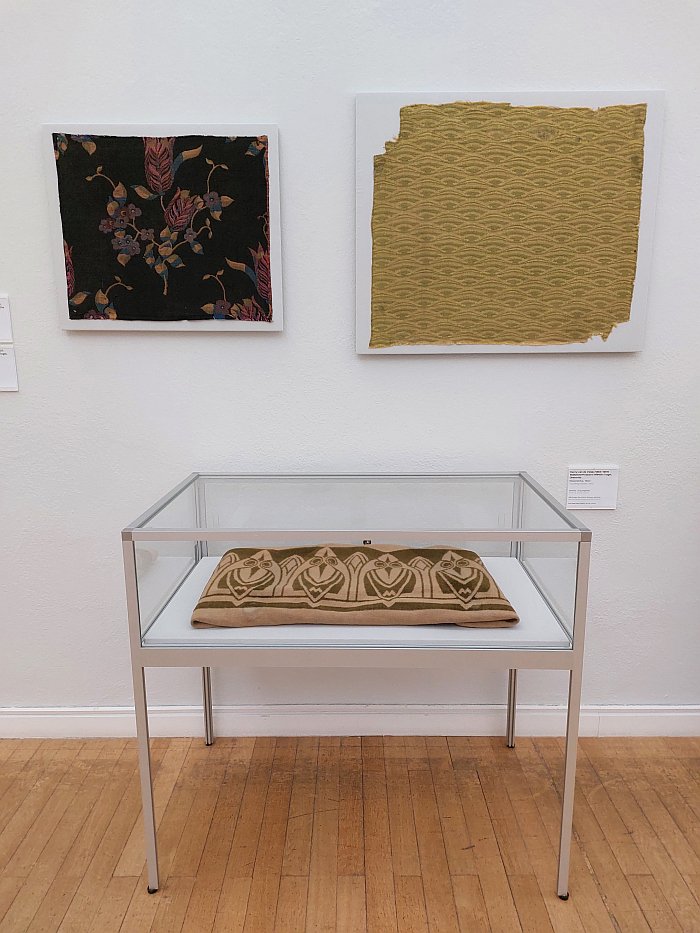
1Henry van de Velde, William Morris, in Henry van de Velde, Kunstgewerbliche Laienpredigten, Hermann Seemann Nachfolger, Leipzig, 1902, page 80
2Henry van de Velde, Geschichte meines Lebens, R. Piper & Co Verlag, München, 1962, page 292
3ibid, page 428
4ibid, page 427
5ibid, page 428
6Karel Sluijterman, uncredited quote as seen in Art Nouveau in Nederland at The Gemeentemuseum, Den Haag, (21.04.2018 to 28.10.2018).
7Kaare Klint, Undervisningen i Møbeltegning ved Kunstakademiet, Arkitekten månedshæfte, October 1930, page 203